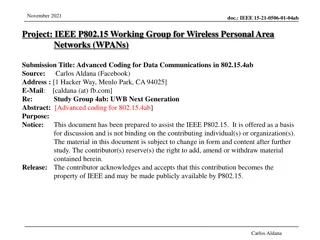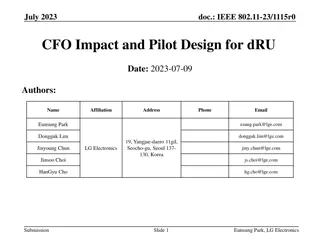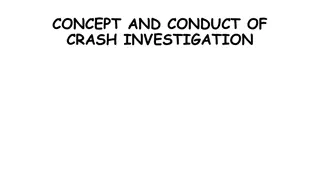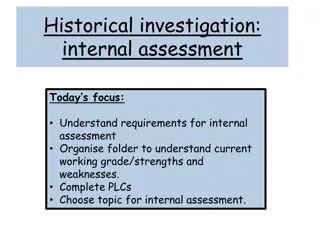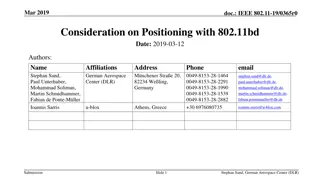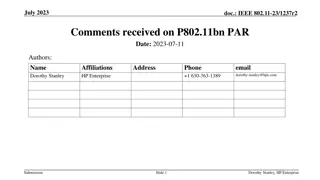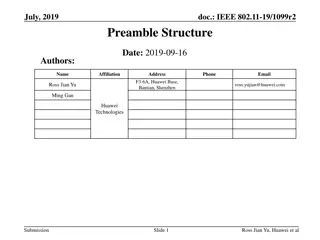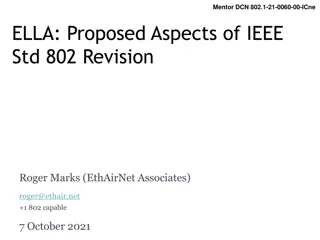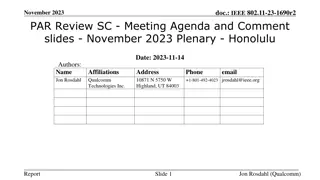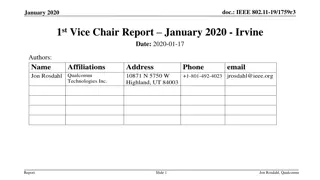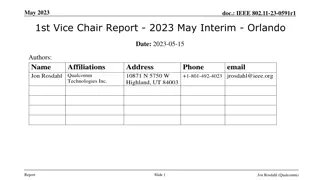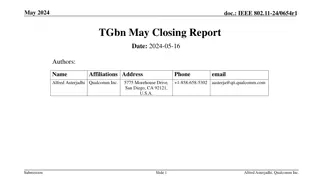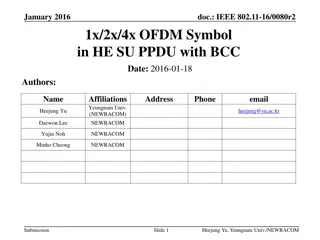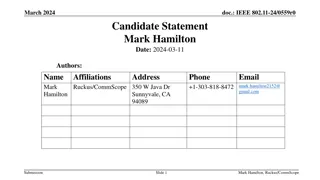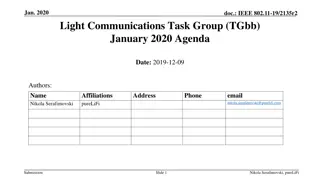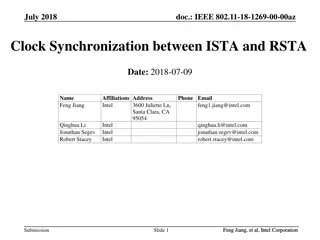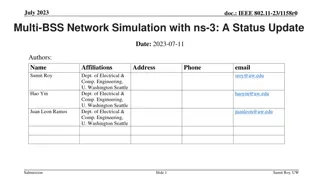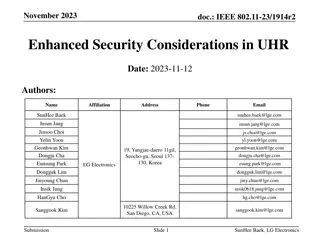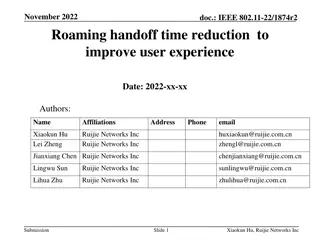Investigation of LDPC Improvements in IEEE 802.11-24
This document delves into the investigation of LDPC (Low-Density Parity-Check) improvements within IEEE 802.11-24 standards. It discusses the history of LDPC codes in 802.11 networks, current FEC (Forward Error Correction) details, a new proposal for LDPC codes, recent LDPC code developments in various technologies like PON, Mgfast, and 5G, comparison of decoder implementations, and AWGN (Additive White Gaussian Noise) performance comparisons. The findings shed light on advancements aiming to enhance data rates, reliability, and overall performance in wireless communications.
Uploaded on Sep 26, 2024 | 0 Views
Download Presentation

Please find below an Image/Link to download the presentation.
The content on the website is provided AS IS for your information and personal use only. It may not be sold, licensed, or shared on other websites without obtaining consent from the author. Download presentation by click this link. If you encounter any issues during the download, it is possible that the publisher has removed the file from their server.
E N D
Presentation Transcript
July 2024 doc.: IEEE 802.11-24/1159r0 Investigation of LDPC Improvements Date: 09-July-24 Name Rainer Strobel Affiliations MaxLinear email rstrobel@maxlinear.com Sigurd Schelstraete I aki Val Marcos Martinez Submission Slide 1 Rainer Strobel, MaxLinear
July 2024 doc.: IEEE 802.11-24/1159r0 Introduction LDPC Codes in 802.11 LDPC FEC was introduced in 2007 for 802.11n and typical data rates in the tens of Mbit/s Codeword length up to 1944 bits at column weight around 3.5 Current Situation Increased data rate results in an OFDM symbol to contain many of FEC codewords In the last years, LDPC codes improved through the introduction in various technologies, e.g., 5G wireless, PON, DSL Ultra-high reliability drives use cases with low PER, where coding gain is increasingly important Submission Slide 2 Rainer Strobel, MaxLinear
July 2024 doc.: IEEE 802.11-24/1159r0 Details of current FEC and new Proposal Current FEC 3 code sizes: N=648, 1296, 1944 4 code rates: 1/2, 2/3, 3/4, 5/6 Quasi-cyclic codes with circulant sizes 27, 54 and 81 Average column weight ~3.5 Double-diagonal structure (simple encoder) New Proposal [4] Additional size N=3888 Same code rate and code structure Submission Slide 3 Rainer Strobel, MaxLinear
July 2024 doc.: IEEE 802.11-24/1159r0 Other recent LDPC Codes PON [3] Single code rate ~0.85 (57/67.5), single code size: N=17280 Circulant size 256, default puncturing 384bit, avg. column weight 4 Mgfast [2] Single code rate 0.75 (18/24) Variable code size 1536-12288 bit, single mother code Cirulant sizes 64-512 bit, default puncturing 1 circulant, avg. column weight 3 5G [1] Variable code size 0.5-0.81 from one code (hybrid ARQ) 22/44-22/27 8 mother codes with 8 shift factors, largest code is 8448 bit payload 2 columns default (data)-puncturing, avg. column weight 4.5 Submission Slide 4 Rainer Strobel, MaxLinear
July 2024 doc.: IEEE 802.11-24/1159r0 This Submission In [4], a high complexity decoder implementation (sum-product decoding with 20 max. iterations) is used. Typical implementations likely use simpler decoders, e.g., min-sum decoding. This submission presents a performance comparison with min-sum decoding with 10 max. iterations. A comparison with LDPC codes used in other technologies is given. Submission Slide 5 Rainer Strobel, MaxLinear
July 2024 doc.: IEEE 802.11-24/1159r0 AWGN Performance Comparison Rate 1/2 code, 4-QAM WIFI L Current code WIFI XL New code from [4] Mgfast Largest Mgfast code, 5632 bit shortened 5G Largest 5G code, 768 bit punctured PON 11520 bit shortened K=972 N=1944 K=1944 N=3888 K=3584 N=7168 K=8448 N=16896 K=3072 N=6144 Submission Slide 6 Rainer Strobel, MaxLinear
July 2024 doc.: IEEE 802.11-24/1159r0 AWGN Performance Comparison Rate 2/3 code, 64-QAM WIFI L Current code WIFI XL New code from [4] Mgfast Largest Mgfast code, 2048 bit shortened 5G Largest 5G code PON 8448 bit shortened K=1296 N=1944 K=2592 N=3888 K=7168 N=10752 K=8448 N=12672 K=6144 N=9216 Submission Slide 7 Rainer Strobel, MaxLinear
July 2024 doc.: IEEE 802.11-24/1159r0 AWGN Performance Comparison Rate code, 256-QAM WIFI L Current code WIFI XL New code from [4] Mgfast Largest Mgfast code, 512 bit punctured (default) 5G K=8448 Largest 5G code, 1024 bit punctured to get rate 3/4 PON K=9216 PON code, 5376 bit shortened to get rate 3/4 K=1458 N=1944 K=2916 N=3888 K=9216 N=12288 N=11264 N=12288 Submission Slide 8 Rainer Strobel, MaxLinear
July 2024 doc.: IEEE 802.11-24/1159r0 AWGN Performance Comparison Rate 5/6 code, 1024-QAM WIFI L Current code WIFI XL New code from [4] Mgfast Largest Mgfast code, 1740 bit punctured 5G Largest 5G code, punctured to 10138 bit PON 384 bit punctured and 1152 bit shortened K=3240 N=1944 K=1620 N=3888 K=9216 N=11060 K=8448 N=10138 K=13440 N=16128 Submission Slide 9 Rainer Strobel, MaxLinear
July 2024 doc.: IEEE 802.11-24/1159r0 Observations from AWGN Simulations The 3888 bit WLAN codes show good performance at a short code length (and thus, low decoder complexity). This gives a good performance/complexity trade-off. At rate , the 5G code performs best (designed for this code rate) At rates 2/3 and , the Mgfast code performs best (designed for code rate ) At rate 5/6, the PON code performs best (designed for a code rate of 0.85) As the MGFAST code provides a good performance on most code rates and constellation sizes, it is used for reference for WLAN channel simulations Submission Slide 10 Rainer Strobel, MaxLinear
July 2024 doc.: IEEE 802.11-24/1159r0 D NLOS 2x2 1 Stream Channel Performance Rate 1/2 code, 4-QAM Up to 1dB gain, depending on the channel, of 3888 bit code at PER 0.01 Rainer Strobel, MaxLinear Submission Slide 11
July 2024 doc.: IEEE 802.11-24/1159r0 D NLOS 2x2 2 Streams Channel Performance Rate 2/3 code, 64-QAM Around 1dB gain of 3888 bit code at PER 0.01 Submission Slide 12 Rainer Strobel, MaxLinear
July 2024 doc.: IEEE 802.11-24/1159r0 D NLOS 2x2 2 Streams Channel Performance Rate 3/4 code, 256-QAM 1-2dB gain with the longer Wi-Fi code Submission Slide 13 Rainer Strobel, MaxLinear
July 2024 doc.: IEEE 802.11-24/1159r0 D NLOS 2x2 2 Streams Channel Performance Rate 5/6 code, 1k-QAM 1-2dB gain with a larger Wi-Fi code Submission Slide 14 Rainer Strobel, MaxLinear
July 2024 doc.: IEEE 802.11-24/1159r0 Observations from D NLOS Simulations SNR gains of larger LDPC like the new Wi-Fi codes on real channels are higher than in AWGN channels. The 3888 bit Wi-Fi code gives a good performance/complexity trade-off. The performance gains obeserved in [4] are visible with a low complexity LDPC decoder, too. The SNR gain of the Mgfast code is higher, but it is 3x the length of the 3888 bit WLAN code. Submission Slide 15 Rainer Strobel, MaxLinear
July 2024 doc.: IEEE 802.11-24/1159r0 Rate-vs.-Range Simulation Nss=2 fixed D NLOS 2x2 2 streams Conditions Observations Rate 3/4, 4QAM doesn t work well (all codes) 4 Channels, 0.2dB SNR steps >10k codewords per SNR 10000 Byte packet no puncturing/shortening (large frame) Submission Slide 16 Rainer Strobel, MaxLinear
July 2024 doc.: IEEE 802.11-24/1159r0 Rate-vs.-Range Simulation Nss optimized Conditions Observations Rate 3/4, 4QAM issue is not visible (1SS used) D NLOS 2x2 1 or 2 streams (opt.) 4 Channels, 0.2dB SNR steps >10k codewords per SNR 10000 Byte packet no puncturing/shortening (large frame) Submission Slide 17 Rainer Strobel, MaxLinear
July 2024 doc.: IEEE 802.11-24/1159r0 Details on Rate-Reach Observations MCS2 vs. MCS3, 2 streams Required SNR for 4QAM, Rate is higher than 16QAM, Rate . This is the case for all codes and thus, not associated with the LDPC code matrix MCS2 SNR-vs.-goodput of larger codes Longer codewords have a much steeper transition from 0 to max. goodput latency improvement MCS3 Higher latency due to packet errors Submission Slide 18 Rainer Strobel, MaxLinear
July 2024 doc.: IEEE 802.11-24/1159r0 Longer Codes for 2.4 GHz Band? A 3888 bit LDPC decoder, as presented in [4] is equivalent to two parallel LDPC decoders for 1944 bit. For higher bandwidth channels, e.g., 160MHz or 320MHz, multiple parallel decoders are typically used and thus, the overhead for introducing a 2x size codeword is small. This may not be the case for 2.4GHz where the max. bandwidth is 40MHz. For the 2.4 GHz band it is recommended not to support 3888 bit LDPC codes to limit the added complexity. Submission Slide 19 Rainer Strobel, MaxLinear
July 2024 doc.: IEEE 802.11-24/1159r0 Conclusions The proposed 3888 bit code shows a performance improvement on the AWGN channel and for WLAN channels, while it is still shorter than other state-of- the-art LDPC codes. Longer LDPC codewords improve latency, as the packet error rate at the max. goodput operationg point is lower. For code performance comparisons, limited decoder complexity (e.g., min- sum 10 iteration) should be considered. New codes shall provide gains with limited decoder complexity. Implementation complexity can be limited by introducing larger codes in 5 and 6GHz bands, only. Submission Slide 20 Rainer Strobel, MaxLinear
July 2024 doc.: IEEE 802.11-24/1159r0 SP Do you agree to not support longer LDPC codewords for 2.4 GHz band? Yes No Abstain Submission Slide 21 Rainer Strobel, MaxLinear
July 2024 doc.: IEEE 802.11-24/1159r0 References [1] 3GPP, Technical Specification Group Radio Access Network; NR; Multiplexing and channel coding (release 15). 3GPP TS 38.212. September 2017 [2] ITU, Multi-gigabit fast access to subscriber terminals (MGfast) - Physical layer specification, ITU-T G.9711, April 2021 [3] ITU, Higher speed passive optical networks - Common transmission convergence layer specification, ITU-T G.9804.2, September 2021 [4] Rethna Pulikkoonattu et.al, Longer Block-Length LDPC Codes , IEEE 802.11-23-1985R0, 2024-05-12 Submission Slide 22 Rainer Strobel, MaxLinear
July 2024 doc.: IEEE 802.11-24/1159r0 APPENDIX Submission Slide 23 Rainer Strobel, MaxLinear
July 2024 doc.: IEEE 802.11-24/1159r0 Simulation parameters Parameter Value Remarks: [4] used sum-product decoding with max. 20 iterations and thus, a much higher complexity decoder as reference LDPC decoder algorithm MinSum Algorithm details Row layered decoding Max. iterations 10 Bandwidth 160 MHz AP TX Power 21 dBm Channel model D NLOS [8] MCS Frequency 5.25GHz Submission Slide 24 Rainer Strobel, MaxLinear







